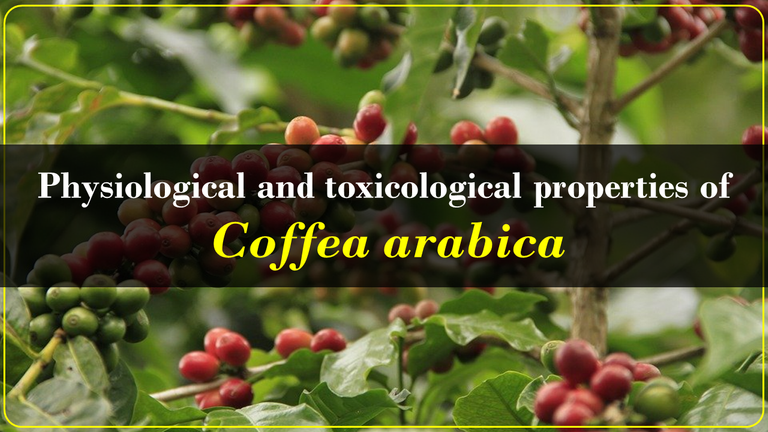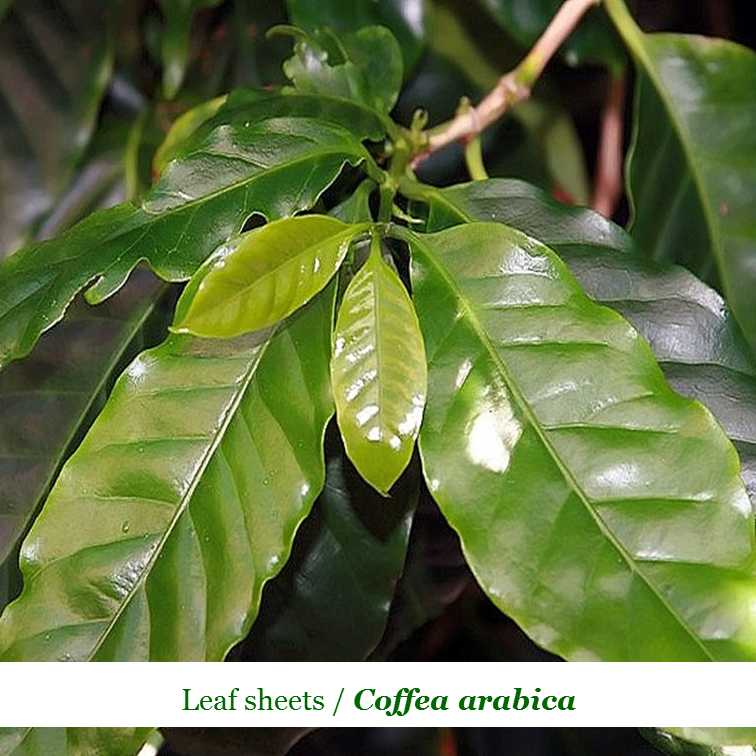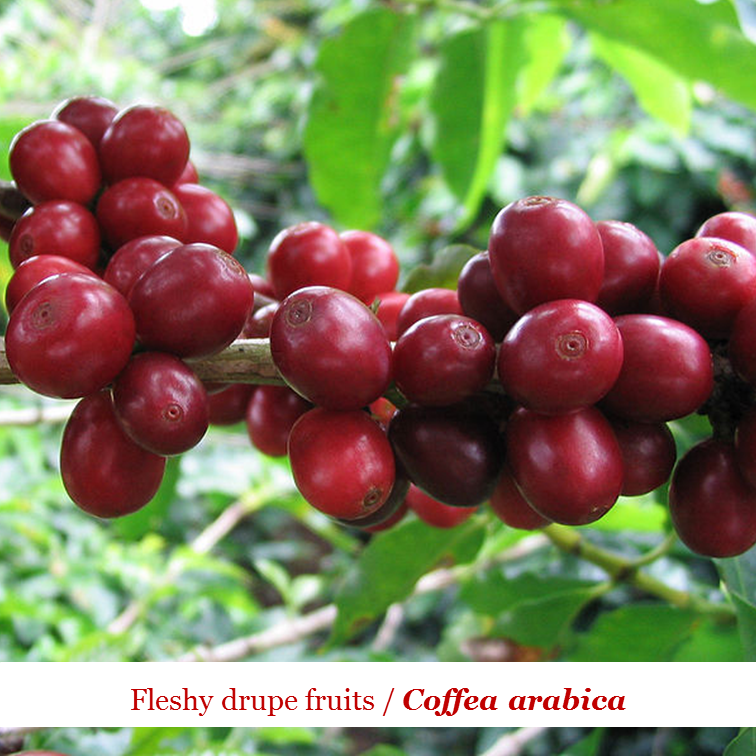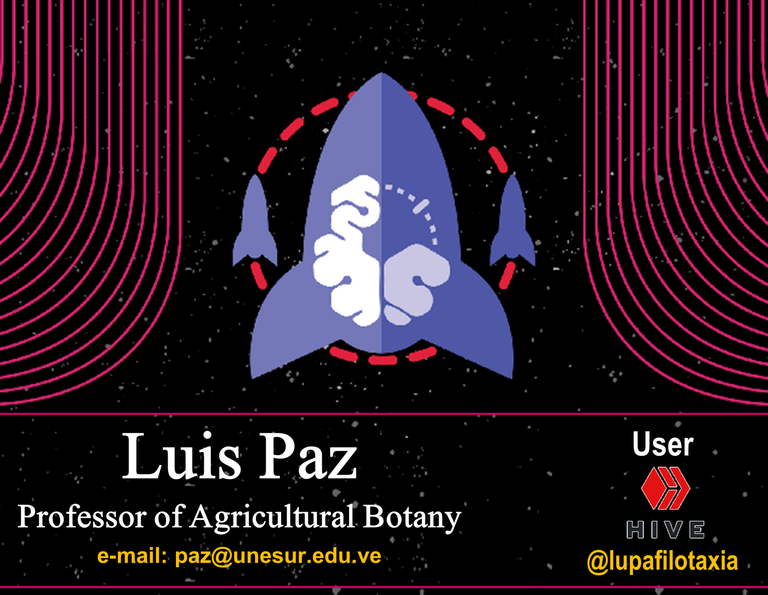Physiological and toxicological properties of Coffea arabica
(Edited)

The purpose of this document is to share scientific information, mainly descriptive content related to the main psychoactive plant species, specifically on the physiological and toxicological properties, general characteristics, pharmacokinetic action, pharmacological effects, psychoactive effects, consumption and legal aspects of the psychoactive plant species Coffea arabica.
Introduction
According to experimental reports, caffeine, the main phytometabolite present in the fruits of Coffea arabica (Coffee), acts contrary to the neuroprotective biochemical processes of the central nervous system, in other words, its physiological interaction decreases, and in some cases blocks the adenosine receptors (biomolecules responsible for regulating the levels of excitation, which are triggered at the level of the central nervous system) thereby generating effects mainly of a psychostimulant, respiratory, and cardiovascular nature.
However, even though these psychostimulant, respiratory and cardiovascular effects that caffeine produces in people are classified as positive reactions to health, its intake in high doses has been associated with psychoactive responses, mainly due to its addictive effects and its relationship with multiple toxicological disorders, among which we can highlight: increased heart rate, gastric disorders, increased blood pressure, and decreased levels of nutrient absorption.
In this sense, and based on some clinical and experimental results on the physiological and toxicological properties of caffeine, the aim of this post is to socialize botanical aspects related to the pharmacokinetic action, pharmacological and psychoactive effects of the species Coffea arabica (Coffee).
General characteristics
Taxonomy and distribution
Coffea arabica is a plant species of woody biotype artificially placed in the Division: Magnoliophyta, Class: Magnoliopsida, Order: Gentianales, Family: Rubiaceae..., Genus: Coffea and Species: arabica, of African origin specifically from Ethiopia, with distribution essentially in predominantly mid-elevation intertropical eco-regional habitats.
Common names
Coffea arabica is vernacularly designated as Coffee plant, or Arabica coffee plant, although, like the rest of the specimens of the genus Coffea it is also identified as Coffee.
Vegetative and reproductive morphology
Specimens of Coffea arabica, exhibit the following morphological profiles; woody stems, simple leaf blades, petiolate, elliptical appearance and opposite phyllotaxy, white flowers with cymose arrangement, fleshy drupe-like fruits, and small oval seeds.

Fig. 2 Leaf sheets Coffea arabica (Coffee). Public domain image, Author: David Stang, 2006 CC BY-SA 4.0 Remark: The photograph was edited by user @lupafilotaxia, by size adjustments and text incorporation.
Edafo-Coffee Climatology
The plants of Coffea arabica, are plant materials that, according to their edaphoclimatic conditions of origin, express their maximum potential in eco-regions located between 1,600 and 2,000 m.a.s.l. (meters above sea level), rainfall greater than 1,500 millimeters per year, average temperature between 18 and 20°C, and soils that exhibit good drainage, depth greater than 50 cm and good permeability.

Fig. 3 Fleshy drupe-like fruits of Coffea arabica (Coffee). Public domain image, Author: Fernando Rebelo, 2005 CC BY-SA 3.0 Remark: The photograph was edited by user @lupafilotaxia, by size adjustments and text incorporation.
Pharmacokinetic action
Coffee methylxanthine alkaloids
Caffeine, is the main biomolecule or methylxanthine alkaloid with psychoactive action that is derived from the nuts of Coffea arabica, however, it also has other phytometabolites of purine bases, among which stand out; theophylline and theobromine, both substances together with caffeine are used by the food industry for the preparation of non-alcoholic beverages such as coffee, tea, chocolate or carbonated liquids, as well as by the pharmacological sector for the preparation of energy drinks and the production of prescription and over-the-counter drugs.
Pharmacokinetics of methylxanthine alkaloids
According to [3], the methylxanthine alkaloids present in Coffea arabica, when entering orally prescribe the following route or pharmacokinetic bioexplorations; A. rapid absorption by the gastrointestinal tract..., B. tissue distribution (body tissues), C. metabolization and excessive activation of the central nervous system, hence, its psychostimulant, respiratory, and cardiovascular effects.
Pharmacological effects
Clinical responses
There are multiple pharmacological effects that have been attributed to the caffeine present in the fruits of Coffea arabica, hence, it is considered the most used psychoactive substance in the world, since its consumption not only acts as an energizer and stimulant of neurons, but also serves as a vehicle for strengthening social interaction, since drinking coffee is qualified as an event of social character, which helps to maintain a healthy coexistence and thus improves the mental health of people.
Addictive effects of coffee
Routes of caffeine consumption
Oral ingestion is the main route of administration of methylxanthine alkaloid substances present in coffee (Coffea arabica), however, they are also usually applied by intravenous injection, mainly in patients who require the prescription of high doses of caffeine to control specific pathologies, among these; analgesic action, attention deficit, imbalances in blood sugar levels, neurodegenerative diseases such as Alzheimer's, respiratory insufficiency (caffeine usually increases the contractility of the diaphragm), and hepatic problems.

Fig. 4 Coffee served in a medium cup. Public domain image, Author: Madri C, 2011 CC BY-SA 3.0 Remark: The photograph was edited by user @lupafilotaxia, by size adjustments and text incorporation.
Toxicological disorders reported
In relation to adverse effects, the toxicological risk factors reported in moderate consumers (200 mg of caffeine/day, equivalent to 2 or 3 small cups of coffee) are varied, among these the most frequent are; insomnia, gastric problems, palpitations, tachycardia, body tremors, and nervousness, while in chronic consumers (500 mg of caffeine/day, equivalent to 4 or 7 small cups of coffee), other adverse effects have been reported such as; excessive anxiety, anxiety crises, decrease in the absorption of nutrients such as iron and calcium, increase in the levels of cholesterol in the blood, signs of fear, and cardiovascular disorders.
Coffee consumption and legal aspects
As a daily beverage
To assure that coffee is a beverage that brings harmful effects to health is an erroneous statement, because its moderate consumption favors multiple pathologies related to mental and physical exhaustion caused by the work activities that people perform day after day. On the other hand, in addition to the positive pharmacological responses, coffee also acts as a nutritional substance, providing carbohydrates, proteins, lipids and minerals such as potassium, calcium, magnesium and phosphorus.
Legal provisions
On a global scale, there is no restriction that prevents the consumption of coffee, therefore, its moderate or chronic intake is legal, however, it is relevant to mention that over time the consumption of coffee was banned in some societies, such as Sweden, where in 1746 its intake was limited because coffee was considered an extremely dangerous product for health, while the most emblematic case occurred in Russia where coffee was catalogued as a poisonous substance.
CONTRIBUTIONS OF THIS PUBLICATION
- Like the previous manuscripts shared with the entire academic community active on the HIVE platform, the published material synthesizes mainly information related to the physiological and toxicological properties of caffeine, the main phytometabolite present in the fruits of Coffea arabica (Coffee), by presenting scientific-technical information on the general characteristics, pharmacokinetic behavior, pharmacological and psychoactive effects reported at the experimental level.
BIBLIOGRAPHICAL REFERENCES CONSULTED AND CITED:
[1] Pardo R., Alvarez Y., Barral D., y Farré M. Cafeína: un nutriente, un fármaco, o una droga de abuso. Adicciones. 2007; 19; 3: 225-238. Article: Online access
[2] Jiménez E. Café I (G. Coffea). Reduca (Biología). Serie Botánica. 2014; 7; 2: 113-132 Article: Online access
[3] Broderick P., and Ashley B. Caffeine and psychiatric symptoms: A review. The Journal of the Oklahoma State Medical Association. 2005; 97; 12: 538 – 42. Article: Online access
[4] Gashaw B., and Shumeta Z. Determinants of Coffee Value Addition by Smallholder Farmers in Jimma Zone, Ethiopia. 2018. Article: Online access
[5] Pranowo D., Perdan C., and Budiarto A. Formulation of Full Instant Functional Drinking Making With Coffee Addition. el–Hayah. 2020; 7; 3: 126 - 132. Article: Online access
OBSERVATION
ATTENTION
Readers and followers
If you wish to read more scientific articles in English or Spanish, of excellent academic quality, do not hesitate to visit #STEMSocial and #STEM-espanol, communities that promote scientific content mainly in the areas of Science, Technology, Engineering and Mathematics.

0
0
0.000
HTTP is in use instead of HTTPS and no protocol redirection is in place. Be careful and do not enter sensitive information in that website as your data won't be encrypted.
It's also a good habit to always hover links before clicking them in order to see the actual link in the bottom-left corner of your browser.
This auto-reply is throttled 1/20 to reduce spam but if it still bothers you reply "OFF HTTP". Or reply REVIEW for manual review and whitelisting.
REVIEW
Thanks for the warning, the links are to scientific journal articles, I have already changed the link to others that do comply with security protocols.
https://twitter.com/lupafilotaxia/status/1360288975542489092
#Posh Twitter:
https://twitter.com/lupafilotaxia/status/1360288975542489092
Hello @lupafilotaxia,
Your pictures are beautiful, and your text very interesting. I love coffee...yes, an addict :) However, on a more serious note: I used to visit a profoundly disabled relative in a nursing home. Many of the residents there had been disabled from birth. If I visited at mealtime, I noticed all the residents (who could consume food by mouth) were given coffee at the end of the meal. I used to wonder at that, but perhaps this sentence helps to explain it:
Thank you for another rich article. I hope you and your family are well.
Regards,
AG
Thanks for your contribution to the STEMsocial community. Feel free to join us on discord to get to know the rest of us!
Please consider supporting our funding proposal, approving our witness (@stem.witness) or delegating to the @stemsocial account (for some ROI).
Please consider using the STEMsocial app app and including @stemsocial as a beneficiary to get a stronger support.